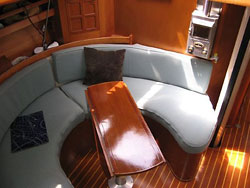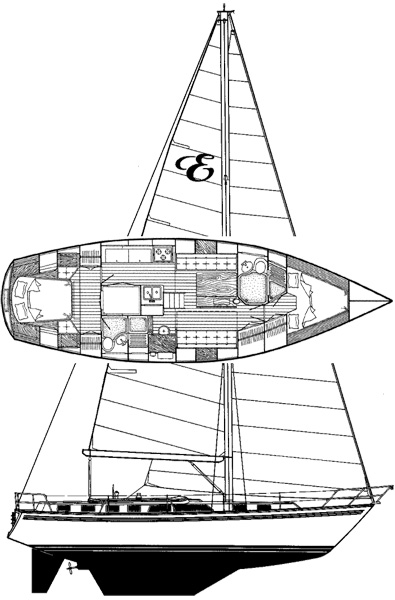| OVERVIEW
DESIGNER: Johan Valentijn
PRODUCTION: 1985-1991
HULLS: About 257 made
SPECIFICATIONS
LOA: 42'3"
LWL: 33'4"
BEAM: 13'0"
DRAFT: 5'0"
DSPL: 25,000lbs
BALLAST: 9,000lbs (internal lead)
DWL: 61' 1.5"
SAIL AREA: 815 sq ft
100% FT: 431 sq ft
MAIN: 384 sq ft
I = 54.75'
J = 16.0'
P = 48.80'
E = 15.75'
See Rigging Specifications for specifics
HEADROOM: 6'4"
BERTHS: 7
FUEL: 75 gal (diesel)
WATER: 2 x 75 gal (hot/cold)
-1990 model:
80gal port, 120gal starboard
-1985 Brochure indicates
2 tanks, 170gal total
HOLDING TANK: two 15 gal
STATISTICS
D/L RATIO: 307
(less than 100 = ULDB
100-200 = light,
200-300 = medium,
+300 = heavy)
SA/D RATIO: 14.55
(14 = low, 22 = high)
BAL/D RATIO: 35.29
(33-45 is average, higher=more stablitiy)
LWL/BEAM: 2.564
(2.3=low, 2.7=medium, 3.0=high)
CAPSIZE RATIO: 1.78
(Less than 2.0 is prefered)
MOTION COMFORT: 34.98
(RANGE = 5 - 60: Higher number means more comfort in a sea)
HULL SPEED: 7.7 knt
PDF DOWNLOADS
E42 BROCHURES:
E42 Sail Plan
E42 1985 Brochure
E42 Spin Sheet Review
E42 PS Review
PERKINS:
PERKINS 4-154 Handbook
PERKINS 4-154 Manual
PERKINS 4-154 Parts Book
|
D E S I G N & & H I S T O R Y H I S T O R Y
In 1985, Endeavour asked America's Cup designer Johan Valentijn to produce the Endeavour 42 and the Endeavour 51 signaling the beginning of a new era, or second generation, of sailboat designs at Endeavour. The first generation of boats Endeavour produced were simple designs (in part based on the CCA design rule), had hand laid FRP hulls, shoal draft keels suited to the shallow waters of Florida Keys and Bahamas, and generally suffered from poor windward performance. These older designs were giving way to market demand for better performing boats.
 The Endeavour 42 is by no means a blue water cruiser, but more attention was given to performance by fitting taller rigs, moving the chain plates inboard and switching to balsa cored topsides. Around 257 of these boats were built between 1985 and 1991 and it is considered a comfortable, good value cruiser for those who enjoy the liveaboard lifestyle. The Endeavour 42 is by no means a blue water cruiser, but more attention was given to performance by fitting taller rigs, moving the chain plates inboard and switching to balsa cored topsides. Around 257 of these boats were built between 1985 and 1991 and it is considered a comfortable, good value cruiser for those who enjoy the liveaboard lifestyle.
H U L L & & D E C K D E C K
The hull is molded as a sandwich core construction of 1” Balsa Grain Balsa Core between laminates (layers) of polyester resin and fiberglass woven roving and multi-directional chopped strand fiber (MCSF). The keel is moldered integrally with the hull and all ballast is contained inside. (Although unconfirmed, we believe that the hull below the waterline is solid FRP, is balsa cored above the water line, and that areas of the deck are either solid FRP or cored with marine ply.)
 The exterior finish is pigmented gelcoat molded onto the fiberglass. The boot and Sheer stripe are sprayed on coating of Imron Paint. The exterior finish is pigmented gelcoat molded onto the fiberglass. The boot and Sheer stripe are sprayed on coating of Imron Paint.
The deck and cockpit, like the hull, are molded as a single unit of a combination of polyester resin and fiberglass woven roving and MCSF. Plywood coring is incorporated between layers of fiberglass in the cabin top, deck, and cockpit sole areas to give additional stiffness. All exterior deck surfaces are a pigmented gelcoat molded onto the fiberglass.
 The joint between the hull and the deck is one of the most important assembly steps in the construction of a yacht. The method used by Endeavour Yacht is simple, strong, and reliable. The joint between the hull and the deck is one of the most important assembly steps in the construction of a yacht. The method used by Endeavour Yacht is simple, strong, and reliable.
 During assembly, the top of the integral hull flange is liberally coated with the combination adhesive/sealant. The deck is then lowered onto the hull and fastened in place with the stainless steel bolts. When the bolts are tightened, the excess compound is forced into all the crevices and out the sides. The teak cap is then installed, bedded in a heavy layer of the same compound and secured in place, doubly ensuring water tightness. During assembly, the top of the integral hull flange is liberally coated with the combination adhesive/sealant. The deck is then lowered onto the hull and fastened in place with the stainless steel bolts. When the bolts are tightened, the excess compound is forced into all the crevices and out the sides. The teak cap is then installed, bedded in a heavy layer of the same compound and secured in place, doubly ensuring water tightness.
B A L L A S T
All ballast is internally mounted inside the keel, which is molded integrally with the hull. Cast pieces of lead are place in the hull, encapsulated in a p0olyester bonding resin, and then covered with a layer of woven roving to form a fiberglass cap. When finished, the ballast becomes a structural part of the hull.
R U D D E R & & S T E E R I N G S T E E R I N G
The rudder is molded as a single piece of solid high density foam with a protective skin of fiberglass and a gelcoat finish. The foam material is of high strength structural grade and has exceptional toughness. The rudder post, molded integrally with the rudder, is solid stainless steel, which is welded to a steel blade in the interior of the rudder. Where the rudder post passes through the hull, water tightness is ensured by means of a stuffing box.
 The pedestal steering system operates with stainless steel cables rotating a radial quadrant bolted and keyed to the rudder post. The cables run through a conduit attached to a massive steel sup[port frame at the rudder and the motor mount then to the pedestal where they are shackled to a stainless steel chain running over a sprocket on the steering wheel shaft. The pedestal steering system operates with stainless steel cables rotating a radial quadrant bolted and keyed to the rudder post. The cables run through a conduit attached to a massive steel sup[port frame at the rudder and the motor mount then to the pedestal where they are shackled to a stainless steel chain running over a sprocket on the steering wheel shaft.
S P A R S & & R I G G I N G R I G G I N G
All spars (mast, boom, and spreaders) are extruded aluminum 6061-T6 alloy, with a protective coating an all external surfaces. The mast on the E42 is stepped through the cabin roof onto the keel.
 The forestay attaches to the stemhead fitting at the bow. This is fabricated of welded stainless steel and through bolted to the hull with back-up plates. All other stays and shrouds are attached to the chainplates at the edge of the cabin house. The forestay attaches to the stemhead fitting at the bow. This is fabricated of welded stainless steel and through bolted to the hull with back-up plates. All other stays and shrouds are attached to the chainplates at the edge of the cabin house.
 These chainplates are stainless steel fittings, either through bolted to the main bulkhead or bolted to the rods. Additional fiberglass reinforcement is packed into the hull in all chainplate areas. These chainplates are stainless steel fittings, either through bolted to the main bulkhead or bolted to the rods. Additional fiberglass reinforcement is packed into the hull in all chainplate areas.
 All standing rigging is attached to the chainplates with adjustable turnbuckles that allow fine tuning of the rigging tension All standing rigging is attached to the chainplates with adjustable turnbuckles that allow fine tuning of the rigging tension
I N T E R I O R
 The E42 was designed as a center cockpit with 1 forward double v-berth, 1 single settee, 1 double convertable settee (circular or traditional dinette), 1 aft double, 2 heads w/showers, and a large aft owners stateroom. The E42 was designed as a center cockpit with 1 forward double v-berth, 1 single settee, 1 double convertable settee (circular or traditional dinette), 1 aft double, 2 heads w/showers, and a large aft owners stateroom.
 Like the other center-cockpit boats Endeaovur designed the salon came with two dinette options: a traditional layout with the satees aliigned athwartships to port and startboard (as shown in the plan on this page) or a circular dinette configuration like that in the photo here. Like the other center-cockpit boats Endeaovur designed the salon came with two dinette options: a traditional layout with the satees aliigned athwartships to port and startboard (as shown in the plan on this page) or a circular dinette configuration like that in the photo here.
 The interior of the E42 is built up of wood. First, a framework of floor timbers is constructed and place in the bilge and heavily bonded in p0lace with woven roving. A plywood sole is glued and screwed on top of these floor timbers and bonded to the hull all around its periphery with woven roving. The interior of the E42 is built up of wood. First, a framework of floor timbers is constructed and place in the bilge and heavily bonded in p0lace with woven roving. A plywood sole is glued and screwed on top of these floor timbers and bonded to the hull all around its periphery with woven roving.
 All timbers and plywood are saturated with polyester resin before assembly to seal all exposed wood. All timbers and plywood are saturated with polyester resin before assembly to seal all exposed wood.
 Next, the entire sole is covered with teak and holly flooring, bonded in place with a waterproof adhesive. All bulkheads are bonded to the hull with two layers of woven roving on both sides. Next, the entire sole is covered with teak and holly flooring, bonded in place with a waterproof adhesive. All bulkheads are bonded to the hull with two layers of woven roving on both sides.
A U X I L A R Y & & P R O P U L S I O N P R O P U L S I O N
All Endeavour models are equipped with inboard diesel engines. The most common auxillary installed was a fresh water cooled 62 HP Perkins 4-154 diesel engine with 2.5 to 1 reduction gear (1983–1986). The Yanmar 4JH is found on most later model boats (1987–1991).
Shaft
All models have solid stainless steel propeller shafts. The diameter of the E42 shaft is 1.25".
 The propeller shaft is supported at the inboard, or engine end, by the shaft coup0ling. A square key is used to prevent turning of the shaft in the coupling. In addition, a stainless steel bolt with locking nut passes through the coupling and shaft to prevent backing out of the shaft in reverse. The propeller shaft is supported at the inboard, or engine end, by the shaft coup0ling. A square key is used to prevent turning of the shaft in the coupling. In addition, a stainless steel bolt with locking nut passes through the coupling and shaft to prevent backing out of the shaft in reverse.
 The shaft passes through the hull at the stuffing box. Water tightness is ensured by the packing material in the stuffing box. A slight dripping, say 3 to 4 drops per minute, under power is normal and desirable. The shaft passes through the hull at the stuffing box. Water tightness is ensured by the packing material in the stuffing box. A slight dripping, say 3 to 4 drops per minute, under power is normal and desirable.
Propellers
The standard propeller supplied with all Endeavour models is a solid bronze, three-blade type. It has a tapered bore that mates to the tapered shaft end and is held in place with two locking nuts and a cotter pin. A square key locks the propeller to the shaft p0reventing any rotational slippage of the prop.
 The mechanical transmission on the diesel engine in the E42 can be placed in the REVERSE gear shift position to prevent the propeller from freewheeling. The mechanical transmission on the diesel engine in the E42 can be placed in the REVERSE gear shift position to prevent the propeller from freewheeling.
 For the Perkins 4-154 engine, the standard propeller size is 17 x 16 RH three blade. The optional propeller size is 17 x 17 RH two blade. For the Perkins 4-154 engine, the standard propeller size is 17 x 16 RH three blade. The optional propeller size is 17 x 17 RH two blade.
Exhaust Size
In the Perkins engine, a water pump draws water through the intake port, circulates it through a heat exchanger, where it is pumped in the muffler and overboard through the exhaust port. The saltwater in the heat exchanger lowers the temperature of the engine coolant circulated through the engine block by means of the normal engine water pump.
Fuel Tank
The fuel tank us built of welded marine grade aluminum with internal baffles. The fuel tank is positioned in the keel cavity in the engine room. All E42 fuel tanks have additional pick up and return fittings for auxiliary generator. If no generator is installed at the factory, these are plugged with removal caps for possible future use.
E L E C T R I C A L . .S Y S T E M
The electrical system has been designed to ensure as much trouble free operation as possible. Wiring and connections are kept as high in the interior of the yacht as practical to reduce exposure to water. Virtually all wiring and connections are accessible by removing panels from under the side decks.
 All ships wiring is plastic coated stranded copper with crimp type connectors used at all junctions of terminals. All D/C wiring is two wire, color coded: red (positive) and yellow (negative). All A/C wiring is three wire, color coded: black (hot), white (A/C common), and green (case ground). All ships wiring is plastic coated stranded copper with crimp type connectors used at all junctions of terminals. All D/C wiring is two wire, color coded: red (positive) and yellow (negative). All A/C wiring is three wire, color coded: black (hot), white (A/C common), and green (case ground).
 Metallic fittings (through hulls, etc.) below the waterline are electrically bonded together with green plastic coated 8 gauge copper wire and connected to a common ships ground and this is done to minimize the effect of the electrolytic action when the boat is used in saltwater. Metallic fittings (through hulls, etc.) below the waterline are electrically bonded together with green plastic coated 8 gauge copper wire and connected to a common ships ground and this is done to minimize the effect of the electrolytic action when the boat is used in saltwater. |


 The E42 was designed as a center cockpit with 1 forward double v-berth, 1 single settee, 1 double convertable settee (circular or traditional dinette), 1 aft double, 2 heads w/showers, and a large aft owners stateroom.
The E42 was designed as a center cockpit with 1 forward double v-berth, 1 single settee, 1 double convertable settee (circular or traditional dinette), 1 aft double, 2 heads w/showers, and a large aft owners stateroom.